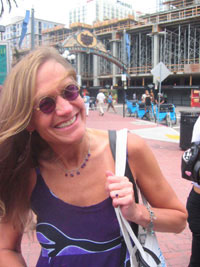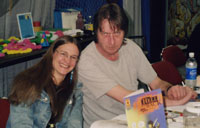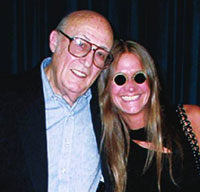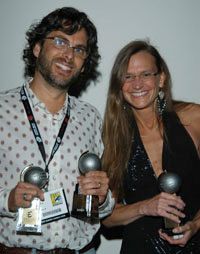Interviews
Interview: Diana Schutz
By Philip Schweier
April 20, 2007 - 10:07
 |
| Dark Horse editor Diana Schutz (photo by F�bio Moon and Gabriel B�.) |
CBB: I understand you were a comics fan as a kid, especially Supergirl. How did you become a comics fan?
Schutz: From the moment I learned to read, I was voracious about it. I discovered my first comics in the waiting room of my dad’s dental office, which happened to be across the street from the local library and not too far from my elementary school. So, on some afternoons, rather than bus home after school, I’d hang out at the library, and then read comics while waiting for my dad to finish work and drive us both home.
My mother also encouraged my comics reading, even though she eventually threw them all out! A fortune in Silver Age DCs – lost! She herself had been a comics reader as a girl. After Sunday mass, we’d stop at the drugstore and buy eight to ten comics for a dollar, and that would keep me out of her hair for the rest of the day.
I was an only child until almost eight years old, so I was kind of a solitary kid anyway, not so great at sports due to a bum knee, and painfully shy. This was back in the early 1960s, and in those days children – especially Catholic schoolgirls – were taught to be seen and not heard, and fiction was a good, safe place in which to retreat.
CBB: What kinds of comics interested you as a child, and why?
Schutz: I was a Mort Weisinger baby – and loved all those wacky Super-types under his editorial aegis: Superman himself, Superman’s Girlfriend Lois Lane, Superman’s Pal Jimmy Olsen, Krypto the Superdog, Streaky the Supercat, Comet the Superhorse – oh my god, Mr. Mxyzptlk! DC superhero comics of the time were charming, innocent fare that nonetheless played to a little girl’s (modest) fantasies, and Supergirl, of course, did that better than all the rest.
Curiously enough, my other favorite comics fare at the time was Stan Lee’s roster of monster titles; I was too young – and too naive – to appreciate Marvel’s superhero line of the ’60s, with their "flawed hero" conceptual underpinnings. But those wild Stan Lee-written stories with titles like "Fin Fang Foom!" or "The Threat of Tim Boo Ba!" – oh, yeah! Most of those were drawn by either Jack Kirby or Steve Ditko, albeit uncredited – but even at that early age, I could always spot the Ditko art. He had such a distinctive, deliciously creepy style to my young eye.
CBB : How did comic books influence you when you were growing up?
Schutz: They warped the crap out of me! And I mean that in the nicest possible way.
Seriously, though, I learned about the world through comics. Another of my favorite titles was Tintin. Growing up in Montreal, I attended a bilingual English/French elementary school, and after second grade, my parents switched me over from the English side of the school to the French – so, as a seven-year-old who spoke only English, I was all of a sudden immersed in French, in a classroom of native French-Canadians. It’s not an exaggeration to say that in those first months, reading Tintin was a lifesaver in terms of my learning this new language.
The general public seriously underestimates the potential of comics as an educational tool. In the case of learning new languages, there’s tremendous power in the association of pictures with words, especially unfamiliar words. I’ve been taking Spanish classes for the last year or so, and reading comics en español has helped a great deal with learning vocabulary.
CBB: In other interviews, you’ve mentioned being in the retail side of the comics industry. At the time, how did you feel you were perceived, in terms of being a woman in what has been a predominantly male hobby?
Schutz: My very first day on the job at The Comicshop in Vancouver, British Columbia, the store’s two owners were asked by a customer, "Who’s the skirt?"
Well, that was 1978 – and the person who asked the question eventually became a dear friend! But that was the prevailing attitude back then: women simply weren’t to be found, either in comics or in the stores. The ones who were, were few and far between. I had the great fortune, over the course of the next few years, to meet several women working in comics who were kind enough to adopt me in various ways and who, in the process, served as strong role models: cartoonists Trina Robbins and Lee Marrs, Eclipse Comics editor in chief Cat Yronwode, and the late Carol Kalish, who was Marvel’s then-representative to the direct sales market. All proved that it was possible, as a female, to exercise both creative and organizational skills in comics, and I learned a lot from them.
But, yeah, working retail over 25 years ago… there were always a few fanboys who just couldn’t deal with a girl behind the counter at the store – especially a girl who knew more about what was going on in Uncanny X-Men than they did. Snikt this, suckah!
Maybe worse, though, were the unwashed customers – literally, I mean – who wanted to spend hours talking my ear off, all close and upfront.Ick.
But those were nonetheless great days, working first for Ron Norton and Ken Witcher at The Comicshop – and then, a few years later, at the Berkeley Comics & Comix store, back when it was still owned by John Barrett and Bud Plant, the flagship of their seven stores in northern California. It was there, by the way, that two then-teenaged kids used to hang out and show me their drawings: Arthur Adams and Mike Mignola!
 |
| Diana Schutz and Sin City creator Frank Miller at the 2000 Wondercon |
It was also in Berkeley that Frank Miller and I first became friends, in December 1981. Frank’s always said it was just "cool" to meet a woman who, like him, loved comics and knew their history.
CBB : What do comics represent to you? Entertainment, business, art form, or something else?
Schutz: All of the above – plus my paycheck!
This is, actually, one of the coolest aspects of the comics medium: it is uniquely American in its genesis, shaped by a variety of technological, commercial, cultural, and aesthetic factors that all came together in this country around the beginning of the twentieth century, as if the stars just aligned in a certain way at that time – and the result was the birth of this amazing medium that is rooted in some very humble, hucksterish beginnings and yet continues, sometimes despite itself, to reach for the sky.
It’s fascinating to study the history of the medium and to realize how market forces have played a tremendous role in its development. When Joseph Pulitzer added a Sunday supplement in 1889 to his New York World newspaper in an effort to build circulation, he launched the first regular Sunday comics section therein. Five years later, the World benefited from a brand-new four-color rotary press, and comics began seeing print in color. Richard Outcault’s
Yellow Kid became a prize possession in the newspaper circulation wars of that time. Comics also grew in popularity as a result of the huge influx of immigrants to New York in the early 1900s: non-English speakers could still read the "funnies." Anyway, these are just a few examples of how all these various social forces impinged on the development of the medium.
And although the academics and literati are only just discovering the fact that comics is an art form – by way of admittedly remarkable works such as Art Spiegelman’s
Maus or Chris Ware’s
Jimmy Corrigan – a hundred years ago Windsor McCay was creating works of art with every page of
Little Nemo in Slumberland, followed by George Herriman with
Krazy Kat, and Frank King with
Gasoline Alley. And in longer comics narratives from those early years, Will Eisner’s
Spirit and Jack Cole’s
Plastic Man are truly without compare, from an aesthetic perspective.
So, to get back to the question… I started working in the industry in 1978; I’ve been a comics editor since 1985; and since 2002 I’ve been teaching a college course in the history and criticism of comics art – so, I guess comics is pretty much an overwhelming passion, my life’s work. That’s what the comics medium represents to me.
CBB: The phrase "women in comics" could be interpreted either as professionals such as yourself, Gail Simone, or Ramona Fradon; or it could be seen as characters, such as Wonder Woman, Elektra, or Princess Leia. By your reckoning, why aren’t there more of either?
Schutz: The readership for comics is still largely male – and most guys just plain aren’t interested in comics by or for women. Or, y’know, even if they are, they keep that on the downlow ’cause it seems to interfere with their own male self-concept. Or something.
Back in the ‘80s, the question of the day was: "Why can’t this character be a woman?" As if putting a bikini and big breasts on an otherwise heroic character might suddenly make the comic book more appealing to women readers. Actually, that just made it more appealing to guys!
One obstacle to female readership is that the superhero genre is still dominant in comics – and superheroes, traditionally, just don’t seem to be the preferred choice of female readers. I’ve been on more "women in comics" panels than I can count, and when we’re inevitably asked what comics we read growing up, I’m always the anomaly – because I liked all those 1960s Superman-family titles. But my female colleagues, if they read comics at all as young girls, read Archies or funny animals – humor comics generally. When the vast majority of available comics jobs are in the superhero genre, or general action-adventure, it helps if you have an affinity for that – and, in the past, most women haven’t.
So, as a woman, if you haven’t really read many comics – because most of what’s out there is targeted at boys – you’re unlikely to consider the medium as a viable career choice. And so the cycle perpetuates itself.
But, happily, things are changing. We’ve had 25 years of
Love & Rockets, for example, and as bookstores have now finally opened the door to graphic novels, they cater to wider tastes than just the traditional superhero fare. When I was in my 20s, my choices were really limited when it came to comics written and drawn for adult women. Now, I can barely keep up with it all! I mean, Jessica Abel’s
La Perdida, Carol Tyler’s
Late Bloomer, Renée French’s
The Ticking, Alison Bechdel’s
Fun Home – these are just some examples that immediately spring to mind from the last year alone! Not to mention all the fabulous strip reprints that are being published now: Herriman’s
Krazy Kat, Schulz’s
Peanuts, Frank King’s
Gasoline Alley strips.
The industry’s hidebound insistence on publishing only superheroes has kept many readers away from this amazing medium – not just women.
 |
| Diana Schutz with comic grand master Will Eisner |
CBB: Professionally speaking, who have been your biggest influences?
Schutz: Back in the early ’80s, both Frank Miller and Chris Claremont helped me move out of comics retail and get my foot in the publishing door. Will Eisner and Dave Sim each took the time to teach me oodles about the medium itself. And Bob Schreck has probably been my greatest influence, both in work and in life.
CBB: Whose work do you admire?
Schutz: Wow! Well, see all of the above. Too many cartoonists to list, really. My preference, however, seems to lie with writer/artists: single cartoonists who both write and draw their own work. That tends to result in a kind of individual, unique, more intimate vision that I prefer – as opposed to the so-called "group-process" comics, where the creative work is divided over many contributors.
CBB : What would be your dream project, working on what character with whom?
Schutz: I guess I don’t think about comics that way. I mean, I don’t really have a burning desire to edit Batman comics or any particular character. A few years ago, Tim Sale gave me the opportunity, in DC’s
Solo #1, to write a Supergirl story for him to draw – in fact, we won a Spanish Haxtur Award for Best Short Story – so I got to exercise my nostalgia jones there for my favorite comic-book character.
 |
| Eisner Winners Michael Chabon and Diana Schutz (Photo by T. DeLeon. Copyright 2005 Comic-Con International.) |
And I’ve really been blessed, through my career, to work with some of the best cartoonists this industry has ever seen: Will Eisner, Frank Miller, Dave Sim, Stan Sakai, Matt Wagner, Barry Windsor-Smith, Paul Chadwick, Eddie Campbell – and recently Jeff Smith on
The Art of Bone. I’ve also gotten to work with some of my favorite writers, too: Michael Chabon, Harlan Ellison, Glen David Gold, Chris Offutt, Brian Vaughan, Neil Gaiman. I mean, how lucky am I?
The "dream," I guess, is to be able to continue to shepherd more meaningful works –more literary graphic novels, like Farel Dalrymple's
Pop Gun War or Paul Hornschemeier's
Mother, Come Home or Fabio Moon and Gabriel Ba's Eisner-nominated
De: Tales.
CBB: What comic book title do you recommend, hoping that everyone would read it?
Schutz: Love & Rockets by Gilbert and Jaime Hernandez, my favorite ongoing comic book. Editing that would be a dream project!
CBB: What’s the most important thing that you feel you have to offer the comic book industry?
Schutz: I don’t know. That’s for others to decide, really.
CBB: What’s the most significant change you’ve seen in the industry in your career?
Schutz: I think probably the advent of creators’ rights. People forget how it was – both for cartoonists and for readers – before creators had the option of owning their own characters and stories. The publishing houses used to own and control everything, and if you wanted to write or draw comics, you were limited in your creative choices: you had to work within the context of the publisher’s existing characters. Or if you created a character of your own, the company would own it – lock, stock, and barrel. You could be fired and see your character go on to make millions of dollars for the company, as was the case with Siegel and Shuster.
Anyway, by the late ‘70s, young upstarts like Frank Miller and Dave Sim and Scott McCloud were pushing for the rights of creators – based on some previous political earthshaking by Neal Adams. And they were able to get away with this because the comics specialty market – the so-called direct market – was coming into being at the same time. This brand-new marketplace for comics was run by people who’d grown up reading comics – the fans – and it catered to a new generation of fans, people who were buying comics based on the artists, not necessarily just the characters. People weren’t buying Daredevil because of the character; they were buying it because of Frank Miller. And so by the mid-1980s, the inmates, as Frank says, had taken over the asylum!
Additionally, the creators’ rights movement, coupled with the formation of the direct market, allowed the proliferation of "independent" publishing houses – independent from Marvel or DC, that is. Fantagraphics, Comico, Eclipse, Dark Horse, Pacific Comics – these were all individually held companies, not corporately owned, and dedicated to the idea of allowing creators their own copyright ownership as well as a significant share of the profits of their work. Back in those days, those were revolutionary concepts!
And this whole movement produced a creative explosion the likes of which gave us such groundbreaking titles as the Hernandez Brothers’
Love & Rockets, Miller and Varley’s
Ronin – and later
Dark Knight Returns and
Sin City and
300 – Watchmen by Moore and Gibbons,
The Rocketeeer by Dave Stevens,
Groo by Sergio Aragonés, Paul Chadwick’s
Concrete, Dean Motter’s
Mr. X, and so on. Creators began to be treated with a lot more respect than in the past; they made more money; they owned their own work; or, at least, they had that option, which had simply not been available in the past.
The result was a more equitable work environment, which itself resulted in better work and a lot more of it.
CBB: What’s the biggest problem facing the comic book industry today, and how would you fix it?
Schutz: By all accounts, reading is becoming obsolete – let alone reading comics. I have no idea how to fix that, and it scares the crap out of me.
CBB: Where do you see the comics field going in the next 10-20 years?
Schutz: Man, if only I had that particular crystal ball… I could retire!
CBB: Generally speaking, what advice do you give to others looking to break into the industry?
Schutz: Work hard! A lot of people have inspiration, but perspiration is in shorter supply! Comics, as an art form, is a lot more difficult than it seems; it’s deceptive in that way. Dave Sim used to tell people that they needed to draw 2,000 pages of comics before they’d get to the stage where one of their pages would be publishable. That’s maybe an exaggeration – but not by much!
The Comic Book Bin would like to extend our sincere thanks to Ms. Schutz for taking the time out from her busy schedule to join us for Women's Month.
Last Updated: March 3, 2025 - 20:40



